英语五种基本句型及练习
- 格式:docx
- 大小:25.37 KB
- 文档页数:5

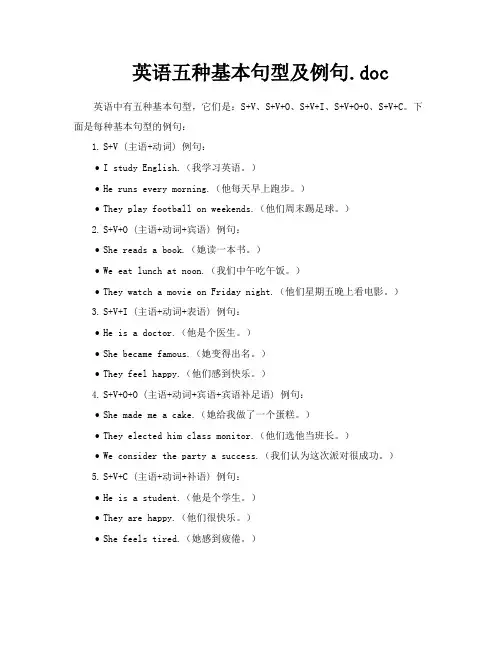
英语五种基本句型及例句.doc 英语中有五种基本句型,它们是:S+V、S+V+O、S+V+I、S+V+O+O、S+V+C。
下面是每种基本句型的例句:1.S+V (主语+动词) 例句:•I study English.(我学习英语。
)•He runs every morning.(他每天早上跑步。
)•They play football on weekends.(他们周末踢足球。
)2.S+V+O (主语+动词+宾语) 例句:•She reads a book.(她读一本书。
)•We eat lunch at noon.(我们中午吃午饭。
)•They watch a movie on Friday night.(他们星期五晚上看电影。
)3.S+V+I (主语+动词+表语) 例句:•He is a doctor.(他是个医生。
)•She became famous.(她变得出名。
)•They feel happy.(他们感到快乐。
)4.S+V+O+O (主语+动词+宾语+宾语补足语) 例句:•She made me a cake.(她给我做了一个蛋糕。
)•They elected him class monitor.(他们选他当班长。
)•We consider the party a success.(我们认为这次派对很成功。
)5.S+V+C (主语+动词+补语) 例句:•He is a student.(他是个学生。
)•They are happy.(他们很快乐。
)•She feels tired.(她感到疲倦。
)这些例句展示了五种基本句型的运用。
它们可以通过改变主语、动词、宾语等部分来构造更多的句子。
熟练掌握这些基本句型,对于学习英语语法和提高英语写作能力非常重要。
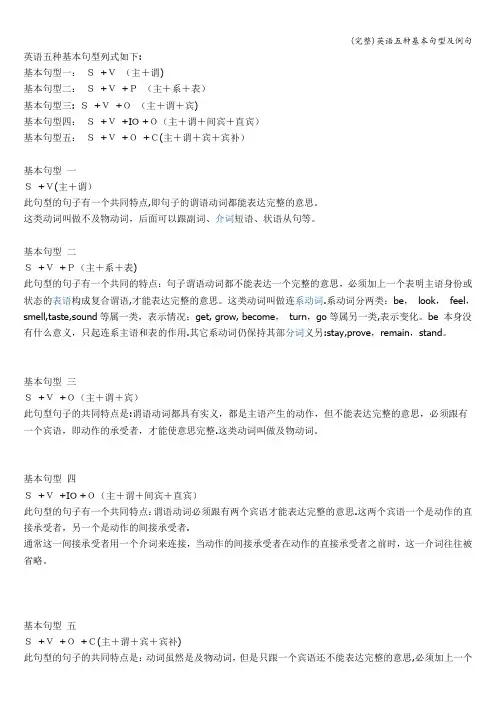
英语五种基本句型列式如下:基本句型一:S+V(主+谓)基本句型二:S+V+P(主+系+表)基本句型三: S+V+O(主+谓+宾)基本句型四:S+V+IO +O(主+谓+间宾+直宾)基本句型五:S+V+O+C(主+谓+宾+宾补)基本句型一S+V(主+谓)此句型的句子有一个共同特点,即句子的谓语动词都能表达完整的意思。
这类动词叫做不及物动词,后面可以跟副词、介词短语、状语从句等。
基本句型二S+V+P(主+系+表)此句型的句子有一个共同的特点:句子谓语动词都不能表达一个完整的意思,必须加上一个表明主语身份或状态的表语构成复合谓语,才能表达完整的意思。
这类动词叫做连系动词.系动词分两类:be,look,feel,smell,taste,sound等属一类,表示情况;get, grow, become,turn,go等属另一类,表示变化。
be 本身没有什么意义,只起连系主语和表的作用.其它系动词仍保持其部分词义另:stay,prove,remain,stand。
基本句型三S+V+O(主+谓+宾)此句型句子的共同特点是:谓语动词都具有实义,都是主语产生的动作,但不能表达完整的意思,必须跟有一个宾语,即动作的承受者,才能使意思完整.这类动词叫做及物动词。
基本句型四S+V+IO +O(主+谓+间宾+直宾)此句型的句子有一个共同特点:谓语动词必须跟有两个宾语才能表达完整的意思.这两个宾语一个是动作的直接承受者,另一个是动作的间接承受者.通常这一间接承受者用一个介词来连接,当动作的间接承受者在动作的直接承受者之前时,这一介词往往被省略。
基本句型五S+V+O+C(主+谓+宾+宾补)此句型的句子的共同特点是:动词虽然是及物动词,但是只跟一个宾语还不能表达完整的意思,必须加上一个补充成分来补足宾语,才能使意思完整.例句1。
They work hard。
主+ 谓2.The flower is dead.主+ 系+ 表3。
Plants need water.主+ 谓+ 宾4。
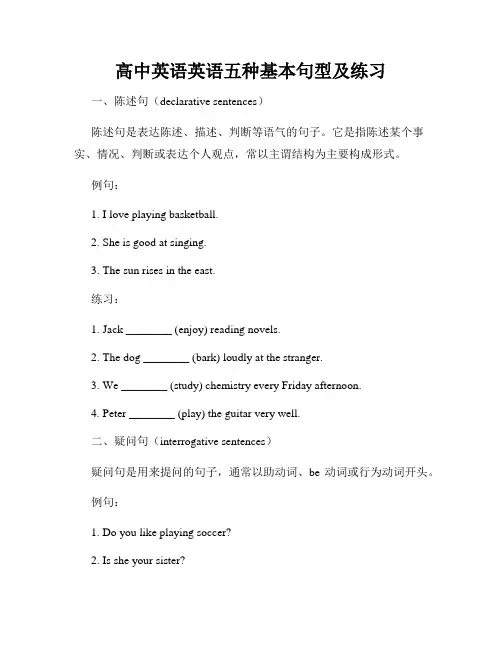
高中英语英语五种基本句型及练习一、陈述句(declarative sentences)陈述句是表达陈述、描述、判断等语气的句子。
它是指陈述某个事实、情况、判断或表达个人观点,常以主谓结构为主要构成形式。
例句:1. I love playing basketball.2. She is good at singing.3. The sun rises in the east.练习:1. Jack ________ (enjoy) reading novels.2. The dog ________ (bark) loudly at the stranger.3. We ________ (study) chemistry every Friday afternoon.4. Peter ________ (play) the guitar very well.二、疑问句(interrogative sentences)疑问句是用来提问的句子,通常以助动词、be动词或行为动词开头。
例句:1. Do you like playing soccer?2. Is she your sister?3. Where is the nearest supermarket?练习:1. ________ you watch TV last night?2. ________ the weather like today?3. ________ Tim have a new car?三、祈使句(imperative sentences)祈使句是用来表达命令、请求、建议等意思的句子。
它通常以动词原形开头。
例句:1. Please close the door.2. Study hard for the exam.3. Let's go for a walk.练习:1. ________ your homework before going to bed.2. ________ your parents for permission before going out.3. ________ up early tomorrow.四、感叹句(exclamatory sentences)感叹句用来表达强烈的感情、惊奇、赞美、喜悦等。
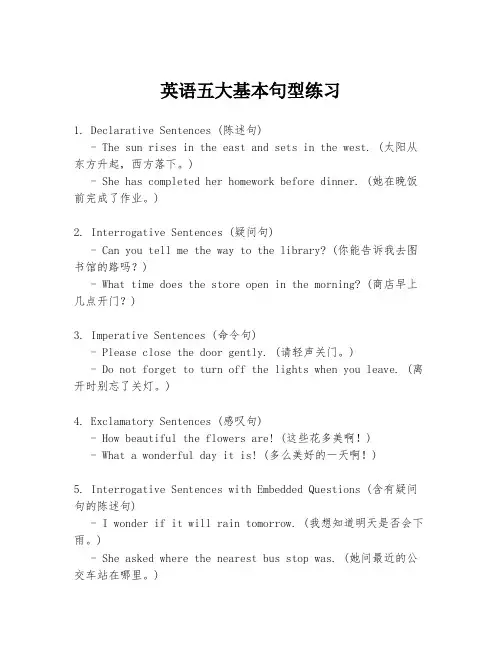
英语五大基本句型练习1. Declarative Sentences (陈述句)- The sun rises in the east and sets in the west. (太阳从东方升起,西方落下。
)- She has completed her homework before dinner. (她在晚饭前完成了作业。
)2. Interrogative Sentences (疑问句)- Can you tell me the way to the library? (你能告诉我去图书馆的路吗?)- What time does the store open in the morning? (商店早上几点开门?)3. Imperative Sentences (命令句)- Please close the door gently. (请轻声关门。
)- Do not forget to turn off the lights when you leave. (离开时别忘了关灯。
)4. Exclamatory Sentences (感叹句)- How beautiful the flowers are! (这些花多美啊!)- What a wonderful day it is! (多么美好的一天啊!)5. Interrogative Sentences with Embedded Questions (含有疑问句的陈述句)- I wonder if it will rain tomorrow. (我想知道明天是否会下雨。
)- She asked where the nearest bus stop was. (她问最近的公交车站在哪里。
)。
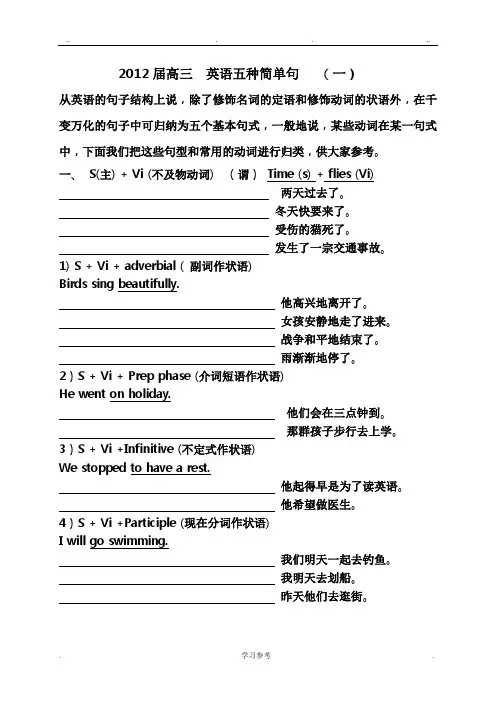
从英语的句子结构上说,除了修饰名词的定语和修饰动词的状语外,在千变万化的句子中可归纳为五个基本句式,一般地说,某些动词在某一句式中,下面我们把这些句型和常用的动词进行归类,供大家参考。
一、S(主) + Vi (不及物动词) (谓)Time (s) + flies (Vi)两天过去了。
冬天快要来了。
受伤的猫死了。
发生了一宗交通事故。
1)S + Vi + adverbial ( 副词作状语)Birds sing beautifully.他高兴地离开了。
女孩安静地走了进来。
战争和平地结束了。
雨渐渐地停了。
2)S + Vi + Prep phase (介词短语作状语)He went on holiday.他们会在三点钟到。
那群孩子步行去上学。
3)S + Vi +Infinitive (不定式作状语)We stopped to have a rest.他起得早是为了读英语。
他希望做医生。
4)S + Vi +Participle (现在分词作状语)I will go swimming.我们明天一起去钓鱼。
我明天去划船。
昨天他们去逛街。
S(主)+ Vt( 及物动词) (谓)+ Object (宾)------- We like English.1)S + Vt + N/ Pron (名词或代词作宾语)I like music. / I like her.他去年教数学。
我们已收到了他们的来信。
2)S + Vt + Infinitive (不定式作宾语)I want to help him.他爸爸期待拥有一家工厂。
他们假装在看书。
我尝试去解决那个问题。
常用于这个句型的动词有:attempt ,dare ,decide, desire, expect, hope, wish, intend, learn, need, offer, pretend, promise, propose, refuse, want, manage, plan, fail, try, agree等。
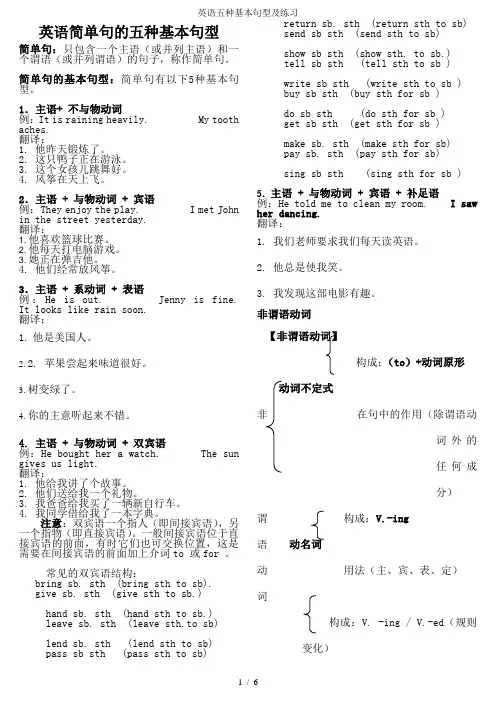
英语简单句的五种基本句型简单句:只包含一个主语(或并列主语)和一个谓语(或并列谓语)的句子,称作简单句。
简单句的基本句型:简单句有以下5种基本句型。
1.主语+ 不与物动词 例:It is raining heavily. My tooth aches. 翻译:1. 他昨天锻炼了。
2. 这只鸭子正在游泳。
3. 这个女孩儿跳舞好。
4. 风筝在天上飞。
2.主语 + 与物动词 + 宾语 例:They enjoy the play. I met John in the street yesterday. 翻译:1. 他喜欢篮球比赛。
2. 他每天打电脑游戏。
3. 她正在弹吉他。
4. 他们经常放风筝。
3.主语 + 系动词 + 表语例:He is out. Jenny is fine. It looks like rain soon.翻译:1. 他是美国人。
2. 2. 苹果尝起来味道很好。
3. 树变绿了。
4. 你的主意听起来不错。
4. 主语 + 与物动词 + 双宾语例:He bought her a watch. The sun gives us light. 翻译:1. 他给我讲了个故事。
2. 他们送给我一个礼物。
3. 我爸爸给我买了一辆新自行车。
4. 我同学借给我了一本字典。
注意:双宾语一个指人(即间接宾语),另一个指物(即直接宾语)。
一般间接宾语位于直接宾语的前面,有时它们也可交换位置,这是需要在间接宾语的前面加上介词to 或for 。
常见的双宾语结构:bring sb. sth (bring sth to sb). give sb. sth (give sth to sb.)hand sb. sth (hand sth to sb.) leave sb. sth (leave sth.to sb) lend sb. sth (lend sth to sb) pass sb sth (pass sth to sb)return sb. sth (return sth to sb) send sb sth (send sth to sb)show sb sth (show sth. to sb.)tell sb sth (tell sth to sb ) write sb sth (write sth to sb ) buy sb sth (buy sth for sb ) do sb sth (do sth for sb ) get sb sth (get sth for sb ) make sb. sth (make sth for sb) pay sb. sth (pay sth for sb)sing sb sth (sing sth for sb )5.主语 + 与物动词 + 宾语 + 补足语例:He told me to clean my room. I saw her dancing. 翻译:1. 我们老师要求我们每天读英语。
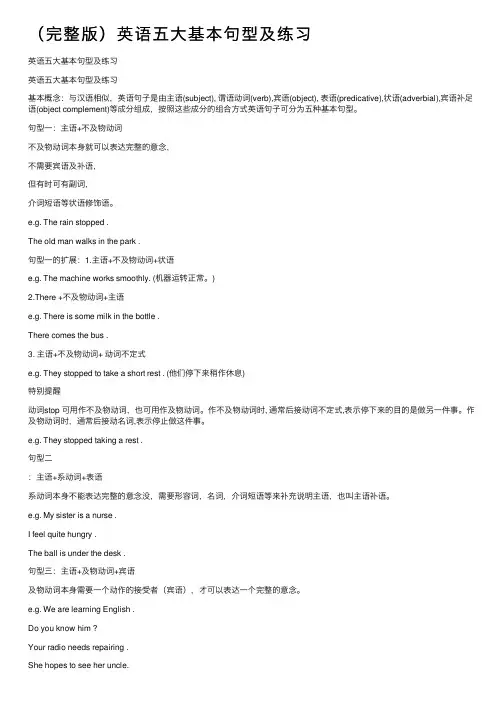
(完整版)英语五⼤基本句型及练习英语五⼤基本句型及练习英语五⼤基本句型及练习基本概念:与汉语相似,英语句⼦是由主语(subject), 谓语动词(verb),宾语(object), 表语(predicative),状语(adverbial),宾语补⾜语(object complement)等成分组成,按照这些成分的组合⽅式英语句⼦可分为五种基本句型。
句型⼀:主语+不及物动词不及物动词本⾝就可以表达完整的意念,不需要宾语及补语,但有时可有副词,介词短语等状语修饰语。
e.g. The rain stopped .The old man walks in the park .句型⼀的扩展:1.主语+不及物动词+状语e.g. The machine works smoothly. (机器运转正常。
)2.There +不及物动词+主语e.g. There is some milk in the bottle .There comes the bus .3. 主语+不及物动词+ 动词不定式e.g. They stopped to take a short rest . (他们停下来稍作休息)特别提醒动词stop 可⽤作不及物动词,也可⽤作及物动词。
作不及物动词时, 通常后接动词不定式,表⽰停下来的⽬的是做另⼀件事。
作及物动词时,通常后接动名词,表⽰停⽌做这件事。
e.g. They stopped taking a rest .句型⼆:主语+系动词+表语系动词本⾝不能表达完整的意念没,需要形容词,名词,介词短语等来补充说明主语,也叫主语补语。
e.g. My sister is a nurse .I feel quite hungry .The ball is under the desk .句型三:主语+及物动词+宾语及物动词本⾝需要⼀个动作的接受者(宾语),才可以表达⼀个完整的意念。
e.g. We are learning English .Do you know him ?句型四:主语+及物动词+间接宾语+直接宾语有些及物动词需要两个宾语才能表达⼀个完整意念。
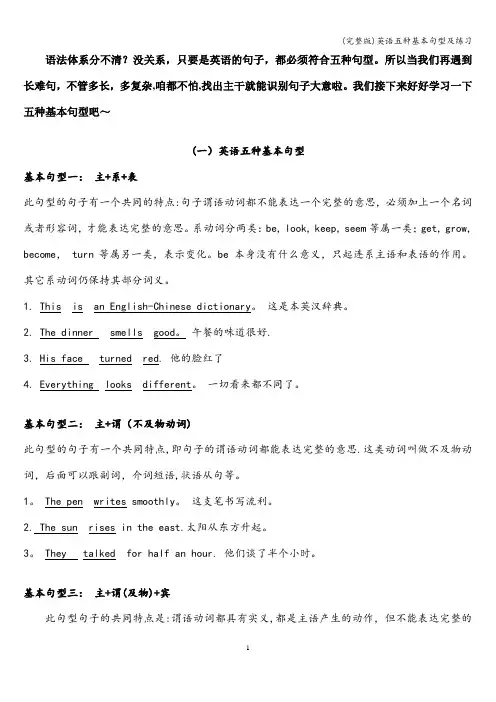
语法体系分不清?没关系,只要是英语的句子,都必须符合五种句型。
所以当我们再遇到长难句,不管多长,多复杂,咱都不怕,找出主干就能识别句子大意啦。
我们接下来好好学习一下五种基本句型吧~(一)英语五种基本句型基本句型一:主+系+表此句型的句子有一个共同的特点:句子谓语动词都不能表达一个完整的意思,必须加上一个名词或者形容词,才能表达完整的意思。
系动词分两类:be, look, keep, seem等属一类;get, grow, become, turn等属另一类,表示变化。
be 本身没有什么意义,只起连系主语和表语的作用。
其它系动词仍保持其部分词义。
1. This is an English-Chinese dictionary。
这是本英汉辞典。
2. The dinner smells good。
午餐的味道很好.3. His face turned red. 他的脸红了4. Everything looks different。
一切看来都不同了。
基本句型二:主+谓(不及物动词)此句型的句子有一个共同特点,即句子的谓语动词都能表达完整的意思.这类动词叫做不及物动词,后面可以跟副词,介词短语,状语从句等。
1。
The pen writes smoothly。
这支笔书写流利。
2. The sun rises in the east.太阳从东方升起。
3。
They talked for half an hour. 他们谈了半个小时。
基本句型三:主+谓(及物)+宾此句型句子的共同特点是:谓语动词都具有实义,都是主语产生的动作,但不能表达完整的意思,必须跟有一个宾语,即动作的承受者,才能使意思完整。
这类动词叫做及物动词。
1。
Who knows the answer?谁知道答案?2. He enjoys reading。
他喜欢看书.3。
My sister is writing a letter at this moment。
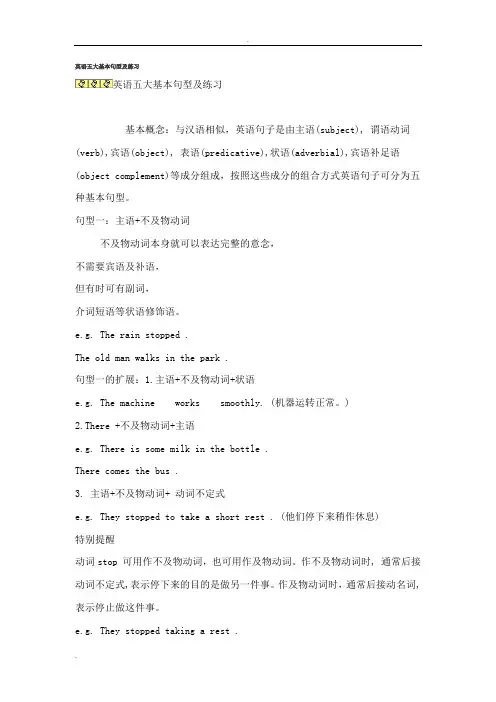
英语五大基本句型及练习英语五大基本句型及练习基本概念:与汉语相似,英语句子是由主语(subject), 谓语动词(verb),宾语(object), 表语(predicative),状语(adverbial),宾语补足语(object complement)等成分组成,按照这些成分的组合方式英语句子可分为五种基本句型。
句型一:主语+不及物动词不及物动词本身就可以表达完整的意念,不需要宾语及补语,但有时可有副词,介词短语等状语修饰语。
e.g. The rain stopped .The old man walks in the park .句型一的扩展:1.主语+不及物动词+状语e.g. The machine works smoothly. (机器运转正常。
)2.There +不及物动词+主语e.g. There is some milk in the bottle .There comes the bus .3. 主语+不及物动词+ 动词不定式e.g. They stopped to take a short rest . (他们停下来稍作休息)特别提醒动词stop 可用作不及物动词,也可用作及物动词。
作不及物动词时, 通常后接动词不定式,表示停下来的目的是做另一件事。
作及物动词时,通常后接动名词,表示停止做这件事。
e.g. They stopped taking a rest .句型二:主语+系动词+表语系动词本身不能表达完整的意念没,需要形容词,名词,介词短语等来补充说明主语,也叫主语补语。
e.g. My sister is a nurse .I feel quite hungry .The ball is under the desk .句型三:主语+及物动词+宾语及物动词本身需要一个动作的接受者(宾语),才可以表达一个完整的意念。
e.g. We are learning English .Do you know him ?Your radio needs repairing .She hopes to see her uncle.句型四:主语+及物动词+间接宾语+直接宾语有些及物动词需要两个宾语才能表达一个完整意念。

句子是由主语、谓语动词、表语、宾语、宾语补足语等组成的。
英语句子有长有短,有简有繁,似乎千变万化,难以捉摸,但其实只有五种基本句型。
所有英语句子都可以看成是这五种基本句型的扩大、组合、省略或倒装。
因此掌握这五大句型,是掌握其他各种英语句子结构的基础。
英语句子依其组合方式可分为以下五种基本句型,句子成分的表示法为: S:Subject(主语), V:Verb (动词),O:Object(宾语), IO : Indirect Object (间接宾语), DO: Direct Object (直接宾语) , P:Predicative (表语), OC: Object Complement(宾语补足语)。
五种基本句型见下表(S=主,V=谓,O=宾,P=表,IO=间宾,DO=直宾,OC=宾补):种类句型例句第1种S+V We work. (不及物)第2种 S+V+O He plays (及物) the piano.第3种S+V+P We are(系动词) students.第4种 S+V+IO+DO She gave(及物) me a pen.第5种 S+V+O+OC He made(及物) the boy laugh.一、第1种句型:S+V(主语+不及物动词)1、Birds fly. 鸟飞。
主语+谓语 (不及物动词)2、He runs in the park. 他在公园里跑。
主语+谓语+地点状语 (不及物动词)此句型是“主语+不及物动词”构成句子的主体部分。
因为是不及物动词,后面当然不能带宾语了,但是可以有状语来修饰。
例如上面例句中的 in the park就是地点状语。
3、Class begins.(begin在句中是不及物动词)上课了。
比较:We begin our class at eight. 我们八点钟开始上课。
该句则属于第2种句型,begin在句中是及物动词,由此可见有些动词既可作及物动词也可以作不及物动词。
英语五大基本句型及练习Basic Concept: Similar to Chinese。
English sentences are composed of subject。
verb。
object。
predicative。
adverbial。
and object complement。
According to the n of these elements。
XXX basic XXX.Sentence Pattern 1: Subject + Intransitive VerbIntransitive verbs can XXX object or complement。
but sometimes they can be modified by adverbs。
nal phrases。
etc.XXX.The old man walks in the park.Sentence Pattern 1 n:1.Subject + XXXe.g。
The machine works XXX.2.There + Intransitive Verb + Subjecte.g。
There is some milk in the bottle.There comes the bus.3.Subject + Intransitive Verb + Infinitivee.g。
They ped to take a short rest.Note:The verb "" can be used as an XXX intransitive verb。
it is usually followed by an infinitive to indicate the purpose of ping to do something else。
When used as a transitive verb。
it is usually followed by a gerund to XXX.XXX.Sentence Pattern 2: Subject + Linking Verb + PredicativeLinking verbs cannot XXX adjectives。
从英语的句子结构上说,除了修饰名词的定语和修饰动词的状语外,在千变万化的句子中可归纳为五个基本句式,一般地说,某些动词在某一句式中,下面我们把这些句型和常用的动词进行归类,供大家参考。
一、S(主) + Vi (不及物动词) (谓)Time (s) + flies (Vi)两天过去了。
冬天快要来了。
受伤的猫死了。
发生了一宗交通事故。
1)S + Vi + adverbial ( 副词作状语)Birds sing beautifully.他高兴地离开了。
女孩安静地走了进来。
战争和平地结束了。
雨渐渐地停了。
2)S + Vi + Prep phase (介词短语作状语)He went on holiday.他们会在三点钟到。
那群孩子步行去上学。
3)S + Vi +Infinitive (不定式作状语)We stopped to have a rest.他起得早是为了读英语。
他希望做医生。
4)S + Vi +Participle (现在分词作状语)I will go swimming.我们明天一起去钓鱼。
我明天去划船。
昨天他们去逛街。
S(主)+ Vt( 及物动词) (谓)+ Object (宾)------- We like English.1)S + Vt + N/ Pron (名词或代词作宾语)I like music. / I like her.他去年教数学。
我们已收到了他们的来信。
2)S + Vt + Infinitive (不定式作宾语)I want to help him.他爸爸期待拥有一家工厂。
他们假装在看书。
我尝试去解决那个问题。
常用于这个句型的动词有:attempt ,dare ,decide, desire, expect, hope, wish, intend, learn, need, offer, pretend, promise, propose, refuse, want, manage, plan, fail, try, agree等。
英语5种基本句型及例句英语的5种基本句型是简单句、并列句、复合句、复杂句和疑问句。
以下将对这5种基本句型进行详细介绍,并给出相应的例句。
1. 简单句简单句是指只包含一个主语和一个谓语的句子。
它可以用来表达一个完整的意思。
例句:- I like to read books.(我喜欢读书。
)- She is a doctor.(她是医生。
)2. 并列句并列句是指两个或多个句子通过连词连接在一起,每个句子都有自己的主语和谓语,表示相对独立的意思。
例句:- He is tall, and she is short.(他很高,她很矮。
)- I like to swim, but I don't like to run.(我喜欢游泳,但我不喜欢跑步。
)3. 复合句复合句是指包含一个主句和一个或多个从句的句子。
主句是句子的核心部分,而从句提供额外的信息。
例句:- I will go to the store if it stops raining.(如果不下雨的话,我将去商店。
)- She is studying because she wants to pass the exam.(她正在学习因为她想要通过考试。
)4. 复杂句复杂句是由一个主句和至少一个从句构成的句子。
从句可以是名词从句、形容词从句或副词从句。
例句:- He told me that he would come to the party.(他告诉我他会来参加派对。
)(名词从句)- The movie, which was directed by Steven Spielberg, was very popular.(这部电影由史蒂文·斯皮尔伯格执导,非常受欢迎。
)(形容词从句)- I will go to bed early so that I can wake up early tomorrow.(我会早点上床睡觉,以便明天早起。
小学英语知识点——五种简单句基本句型·例句句式1:主语+ 谓语(即“主谓”句型)[例句] They arrived. 他们到了。
[分析]主语+谓语=they+arrived句式2:主语+谓语+宾语(即“主谓宾”句型)[例句]I played football last Friday. 上周五我踢球来着。
[分析]主语+谓语+宾语=I+played+football句式3:主语+谓语+间接宾语+直接宾语(即“主谓双宾”句型)[例句] The teacher taught us English. 这位老师教过我们英语。
[分析]主语+谓语+间接宾语+直接宾语=the teacher+taught+us+English句式4:主语+谓语+宾语+宾语补足语(即“主谓宾宾补”句型)[例句]He asked her to go there. 他让她去那里。
[分析]主语+谓语+宾语+宾语补足语=he+asked+her+to go there句式5:主语+系动词+表语(即“主系表”句型)[例句]I am a teacher. 我是一位老师。
[分析]主语+系动词+表语=I+am(be)+a teacher(表明主语身份)小学英语知识点——五种简单句基本句型·例句句式1:主语+ 谓语(即“主谓”句型)[例句] They arrived. 他们到了。
[分析]主语+谓语=they+arrived句式2:主语+谓语+宾语(即“主谓宾”句型)[例句]I played football last Friday.上周五我踢球来着。
[分析]主语+谓语+宾语=I+played+football句式3:主语+谓语+间接宾语+直接宾语(即“主谓双宾”句型)[例句] The teacher taught us English. 这位老师教过我们英语。
[分析]主语+谓语+间接宾语+直接宾语=the teacher+taught+us+English句式4:主语+谓语+宾语+宾语补足语(即“主谓宾宾补”句型)[例句]He asked her to go there.他让她去那里。
英语五种基本句型基本句型一:主+谓(不及物:不加宾语的动词)1. The sun │was shining. 太阳在照耀着2. The moon │rose. 月亮升起了.3. They work hard4. Many animals live in trees。
5. The children are playing happily基本句型二:主+系+表1. This │is │an English-Chinese dictionary. 这是本英汉辞典.2. The dinne r │smells │good. 午餐的气味很好.3. The flower is dead.4. He became a famous doctor.5. The apple pie tastes really delicious。
基本句型三:主+谓(及物:可加宾语的动词)+宾1. Who │knows │the answer?谁知道答案?2. He │admits │that he was mistaken. 他承认犯了错误3. Plants need water.4. The Greens enjoy living in China.基本句型四:主+谓(及物)+双宾(间宾+直宾)1. She │ordered │herself │a new dress. =She ordered a new dress for herself.她给自己定了一套新衣裳.2. I │showed │him │my pictures. 我给他看我的照片.3. He gives me some seeds4. My aunt bought me a computer. = My aunt bought a computer for me.5. I passed him the salt. = I passed the salt to him。
英语简单句的五种基本句型do sb sth (do sth for sb ) get sb sth (get sth for sb )简单句:只包含一个主语(或并列主语)和一个谓语(或并列谓语)的句子,称作简单句。
简单句的基本句型:简单句有以下5种基本句型。
1 .主语+不及物动词例: It is raining heavily. My tooth aches.翻译:1. 他昨天锻炼了。
2. 这只鸭子正在游泳。
3. 这个女孩儿跳舞好。
4. 风筝在天上飞。
2 •主语+及物动词+宾语例: They enjoy the play. I met John in the streetyesterday.翻译:1•他喜欢篮球比赛。
2. 他每天打电脑游戏。
3. 她正在弹吉他。
4. 他们经常放风筝。
3 .主语+系动词+表语例: He is out. Jenny is fine. It looks likerain soon.翻译:1. 他是美国人。
2.2.苹果尝起来味道很好。
3. 树变绿了。
4. 你的主意听起来不错。
4.主语+及物动词+双宾语例: He bought her a watch. The sun gives us light.翻译:1. 他给我讲了个故事。
2. 他们送给我一个礼物。
3. 我爸爸给我买了一辆新自行车。
4. 我同学借给我了一本字典。
注意:双宾语一个指人(即间接宾语),另一个指物(即直接宾语)。
一般间接宾语位于直接宾语的前面,有时它们也可交换位置,这是需要在间接宾语的前面加上介词to或for 。
常见的双宾语结构:bring sb. sth (bring sth to sb).give sb. sth (give sth to sb.)hand sb. sth leave sb. sth (ha nd sth to sb.) (leave sth.to sb)lend sb. sth (lend sth to sb) pass sb sth (pass sth to sb)return sb. sth (return sth to sb) send sb sth (send sth to sb)show sb sth (show sth. to sb.) tell sb sth (tell sth to sb )write sb sth (write sth to sb )buy sb sth (buy sth for sb )动词不定式非词make sb. sth (make sth for sb) pay sb. sth (pay sth for sb)sing sb sth (sing sth for sb )5. 主语+及物动词+宾语+补足语例: He told me to clean my room. I saw her dancing. 翻译:1. 我们老师要求我们每天读英语。
2. 他总是使我笑。
3. 我发现这部电影有趣。
非谓语动词【非谓语动词】构成:(to)+动词原形{在句中的作用(除谓语动词外的任何成分)构成:V.-i ng用法(主、宾、表、定)「构成:V. -ing / V.-ed (规则变化)一用法(表、补、定、状)(一)动名词一、动名词的构成:动名词一般由“动词原形+ing”构成注意:英语中有一些词后面常跟动名词作宾语。
我们初中阶段常见的有:fini sh, mind, be worth, be busy, practice,have fun, have trouble/problem (in), spend... (in), feel like, be used to (习惯于),give up, keep on, consider,suggest, can't help。
我们可按下面的顺口溜记忆这些词。
完成实践值得忙(finish, practice, be worth, be busy )继续习惯别放弃(keep on, be used to, give up)考虑建议不禁想(consider, suggest, can't help, feel like )喜欢思念要介意(enjoy, miss, mind )一、动词不定时的构成不定时的基本形式为:to+动词原形,有时可以不用to, 这里的to是不定式符号,本身无词义,动词不定式的否定形式是not+ (to+ )动词原形。
、动词不定式的句法功能1.不定式作主语动词不定式作主语时,常用it作形式主语,而将真正的主语放在句末其结构为:lt+be+adj. (+ for/ of sb. )+动词不定式女口:To learn English well is useful.It is useful to learn En glish well.It ' important for us to protect the environment.注意:在kind , good, nice, clever 等表示人的品质的形容词后,不用for而用of。
如:It's very kind of you to help me. 你帮助我真是太好啦。
It's very clever of you to do like that.你那样做真是太聪明啦。
2. 不定式作宾语有些谓语动词后只能用不定式作宾语,常见的这类词是表示命令、打算或希望的,如:would like, like, want, wish, hope, decide, pla n, expect等。
如:Would you like to see a film this evenin g? 你今晚想去看电影吗?②在find, think后跟不定式作宾语时,常用it代替,而将真正的宾语放在后面。
如:I find it easy to read En glish every day.③常见的一些不带to的动词不定式Why not do..., Why don't you do..., had better ( not) do..., would rather do,could/would/will you please ( not) do...I would rather stay in the room.我宁愿待在房间里。
3. 不定式作宾语补足语不定式作宾语补足语时与宾语有逻辑上的主谓关系。
女口: Lucy asked him to turn down the radio. 露西让他关小收音机。
tell, ask, want, allow, get, would like, en courage 后常跟动词不定式作宾语补足语。
如:My mother en courages me to lear n Japa nese. 我妈妈鼓励我学日语。
注意:还有一些使役动词和感官动词也用不定式作宾补,这时不定式要省略to。
这些动词有:一感(feel)、二听(hear, listen to )、三让(let, make, have)、四看(look at, see, watch, notice )。
但变被动语态时,必须加上to。
如:My friends were made to work the whole night by the boss.老板让我的朋友们工作了一整夜。
4. 不定式作定语①不定式作定语时,应放在名词之后。
②There is no thi ng to worry about. 没有什么可担心的。
③Beiji ng is a good place to visit.The teacher is telling the students what to do . 老师正告诉学生们做什么。
He did n't kn ow where to go .他不知道去哪里。
例题( )1. Tom's mother told him ________ eating too much meat.A: stopp ing B: to stop C: stops D: stopped ( )2. We don't know ___________ it n ext. Let's go and ask Mr. Li.A: what to do B: to do whatC: whether to do D: to do whether ( )3. How kind you are! You always do what you can ____ me.A: help B: helpi ng C: to help D: helps ( ___ )4 Drivers should n't be allowed _______________ after drinking, or they will break the law.A: drive B: driv ing C: to drive( )5. Water Park is a good place _______ .A: to have fun B: have funC: hav ing fun D: to have a fun( )6. Take time to relax by listening to music, readi ng a book or just spe nding some timealone. Relaxing allows you ___ t o your studieswith more en ergy.A: return B: to return C: returni ng( )7. Nick, would you mind ___________ those old jea ns? They look terrible.A: not to wear B: not wearC: weari ng not D: not weari ng ( )8. —_______ a volun teer is great.—I thi nk so. Some of us want______ volun teersfor the London Olympics.A: Being ;being B: To be; beingC: Being;to be D: To be; to be ( )9.—Don't forget _____ your history and politics books tomorrow morni ng.—Than ks. I won't.A: bring B: to bring C: bringing()10.—What about __________ a rest?—OK. Let's go out and have a walk.A: to take B: takes C: tak ing5. 不定式常和疑问词what, which, when, where, how 连用,相当于一个宾语从句。